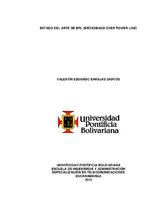Estado del arte del BPL (Broadband Over Power Line)
Fecha
2013-08-28Director/Asesor
Restrepo Agudelo, Raúl
Tipo de contenido
book
Citación
Metadatos
Mostrar el registro completo del ítemDocumentos PDF
Resumen
El objetivo general de esta investigación es la elaboración del estado del arte de la tecnología BPL. El proyecto indica la evolución de PLC de banda angosta a PLC de banda ancha (BPL) y sus principales características, desde los métodos de modulación hasta los problemas de interferencia ocasionados. Este documento está dividido en 8 capítulos, los cuales dan a conocer la tecnología de banda ancha sobre las líneas eléctricas, sus ventajas, sus problemas, sus inconvenientes, sus progresos, su evolución. Se analiza el avance de BPL y la superación de inconvenientes que se han presentado a través del tiempo, los problemas de interferencia ocasionados y cómo se han logrado disminuir. También se indican las principales estructuras para ofrecer el servicio en la última milla, es decir por medio de la línea eléctrica de baja tensión y por medio de redes inalámbricas WLAN IEEE 802.11. Se estudian los entes organizados que regulan y estandarizan la transmisión BPL para el servicio de banda ancha, se estudia la asociación HomePlug Powerline Alliance, la regulación por parte de la FCC y el estudio por parte de la IEEE para la estandarización de la tecnología BPL. En una sección del proyecto se muestran los principales fabricantes de productos y empresas que ofrecen el servicio de BPL, miembros de la asociación HomePlug Powerline Alliance. Por otro lado se estudian desarrollos locales sobre BPL y se da una opinión sobre el posible futuro de esta tecnología. El proyecto en general informa al lector como se encuentra la tecnología BPL en este momento, sus beneficios, sus inconvenientes y su evolución. The general purpose of this research is to develop the state of art of BPL technology. The project shows the evolution of narrow-band PLC to broadband PLC (BPL) and its main characteristics, from the modulation methods to the caused interference problems. This document is divided into 8 chapters, which make known the technology of broadband over power lines, its advantages, its problems, their drawbacks, its progress, and its evolution. It is analyzed the advance of BPL and the overcome of inconveniences that have occurred over time, interference issues and how they have decrease. It also identifies the main structures to provide the service in the last mile, i.e. through low-voltage power line and wireless networks using IEEE 802.11 WLAN. It is studied the organized entities that regulate and standardize the BPL transmission for broadband service, the association HomePlug Powerline Alliance, the regulation by the FCC and the study by the IEEE for standardization of BPL technology. A section of this project shows the major manufacturers and developers offering BPL service, members of the association HomePlug Powerline Alliance. In another section it’s studied local developments of BPL and I give an opinion about the possible future of this technology. The overall project informs the reader the state of BPL technology at this time, its benefits, its drawbacks and its evolution.
Palabra/s clave
Tesis y disertaciones académicas
Líneas eléctricas
Red eléctrica
Redes inalámbricas WLAN IEEE
Colecciones
- Trabajos de grado [6468]


